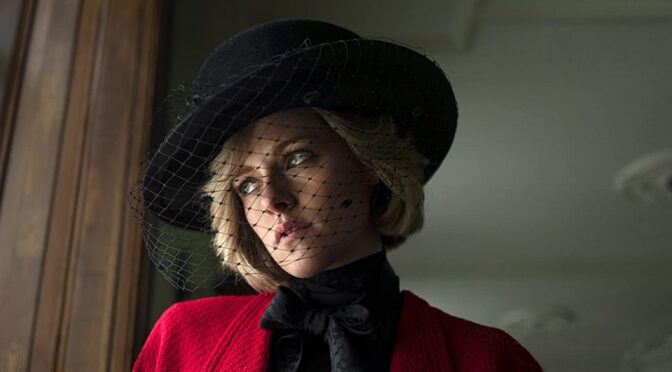Since the death of Princess Diana in 1997 (and, indeed, before), few figures have been a stronger magnet for public sycophancy and tawdry tabloid voyeurism than the late “People’s Princess”. However, Pablo Larraín’s portrait of Diana uses her maddening experience as a reluctant member of the Royal Family to illustrate the stultifying and flattening experience of trying to remain sanguine in the face of a phlegmatic national culture.
The film picks up in December 1991, following Diana (Kristen Stewart) during her trip to Sandringham to spend Christmas with the Royal Family. She has long since drifted from Charles and is regarded with haughty suspicion and lack of patience by them. With her nearby childhood home, Park House, looming in the film’s ever-present misty haze, we are placed unambiguously with her point of view, with all the mental challenges and internal parallels to her situation she contemplates.
The clear issue such a setup presents – given it should already be evident from Larraín’s filmography that this will not be a saccharine biopic – is Diana’s experience coming across as ‘first world problems’. However, SPENCER cleverly uses this dysfunctional family setup – and an off-kilter presentation of it – to ponder what it may reflect about British culture. The film opens in the royal kitchen with a sign ostentatiously declaring the staff should “Keep noise to a minimum. They can hear you”. The air may be thin this high up in society, but it can feel suffocating all the way down.
“Diana’s experience [may have] across as ‘first world problems’. However, SPENCER cleverly uses this dysfunctional family setup – and an off-kilter presentation of it – to ponder what it may reflect about British culture.”
The ‘they’ in question is the Royal Family. Still, Larraín’s shotmaking goes on to establish a broader and more ominous presence than the malevolent dunderheads that constitute the Queen’s progenies. The British military rumbles into Sandringham with deliveries in that same opening as an imposing and relentless cavalcade, sweeping over a dead pheasant to deliver a hedonistic bounty to the head of state. As Diana strides out across the grounds in the nighttime mist, seeking some form of respite, she is intercepted from nowhere by uniformed police. The only individual she connects with, her dresser, Maggie (Sally Hawkins), is unceremoniously reassigned. The winding corridors of the royal home – and how Larraín and cinematographer Claire Mathon shoot Stewart within them – owe more to Kubrickian horror than glamorous portrayals.
“The winding corridors of the royal home – and how Larraín and cinematographer Claire Mathon shoot Stewart within them – owe more to Kubrickian horror than glamorous portrayals.”
In this regard, it is also important to note Timothy Spall’s role as the (fictional) ex-military man Major Alistair Gregory, a seemingly implacable Scot tasked with keeping the press at arm’s length and royal standards for the occasion upheld. His interpretation of this manifests as overbearing attention on paparazzi favourite Diana. Spall is magnificent in the role, acting almost as a spectre, haunting Diana, always merely a curt greeting away, and lacing every statement with subtext. On a more fantastical note, the parallels this version of Diana draws between herself and Anne Boleyn goes some way to demonstrating the diseased plant personified in this most British of institutions has deep roots.
Some of the more overt metaphors can be thuddingly obvious (the curtains sewn shut to block out paparazzi, but also any light, quite literally hemming in Diana), and dialogue exchanges will sometimes elevate the subtextual too far. However, the script, Jonny Greenwood’s discordant jazz-like score, and visuals continually emphasise the passive aggressive atmosphere. One particularly engaging sequence – a confrontation with Charles over a snooker table – gradually shifts the visual perspective and the tone as the conversation progresses from stand-offish impatience to naked disdain. The contrasting presentation of household figures – such as Sean Harris’s royal chef – and the treatment Diana receives from them serves to alienate us even further from the aristocratic ones.
SPENCER works on a surface level as a characterisation of a woman yearning to tarnish her gilded cage. However, its more lasting impact comes from its use as a microcosm to show the damaging broader character of a society that encourages – and enforces – being proper and not making a fuss above all else.

